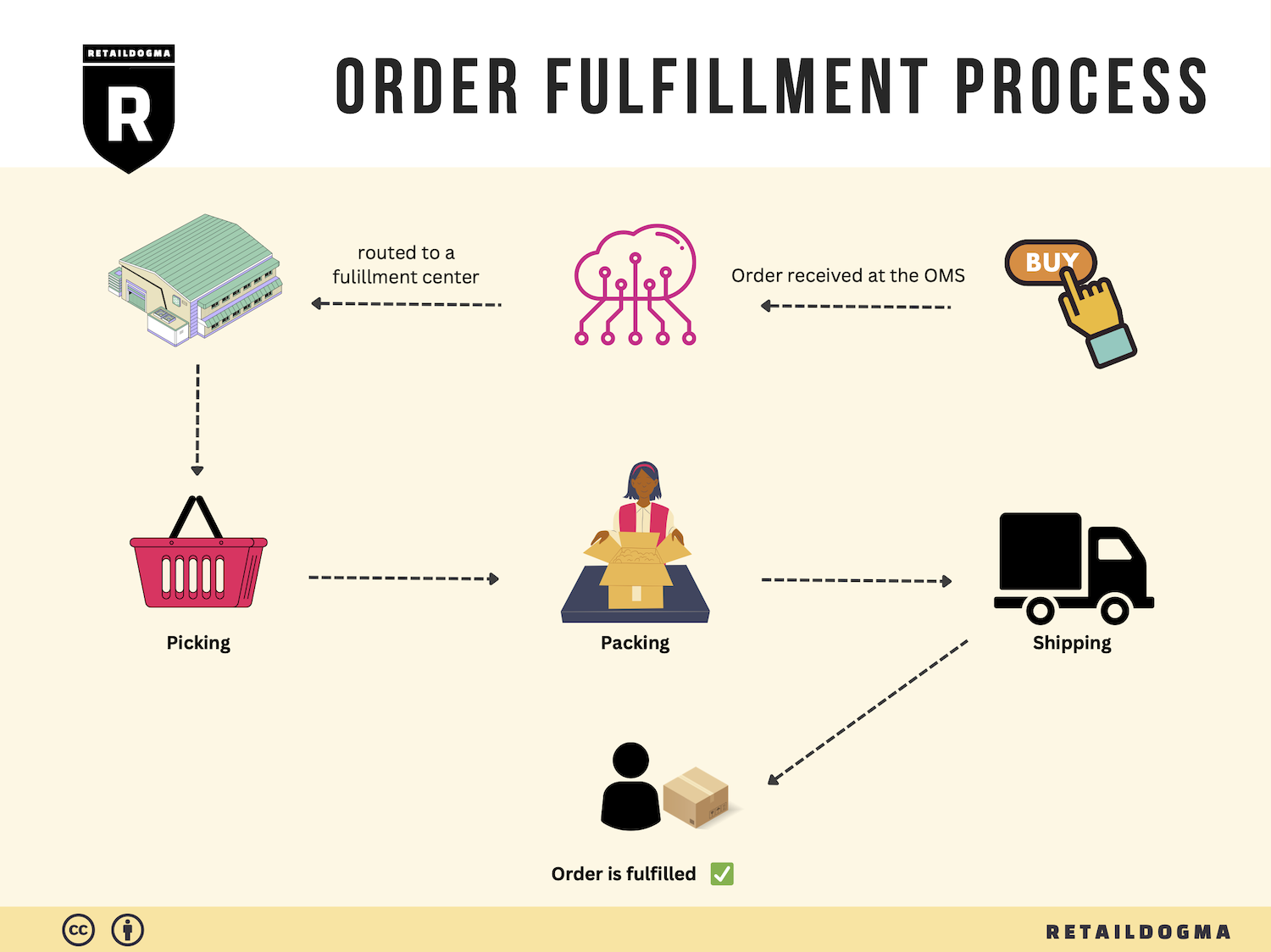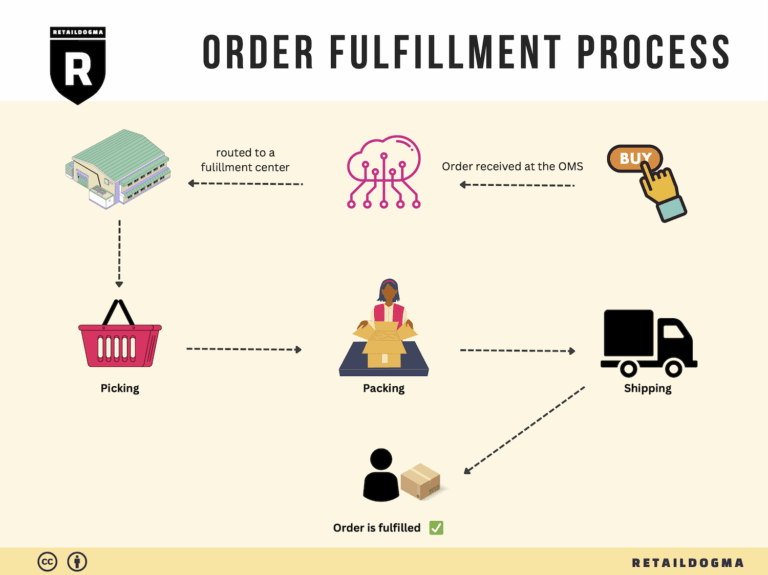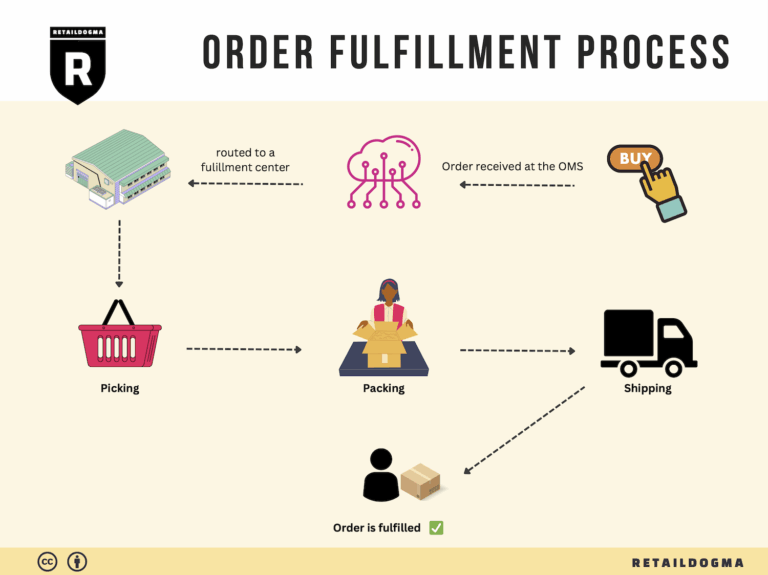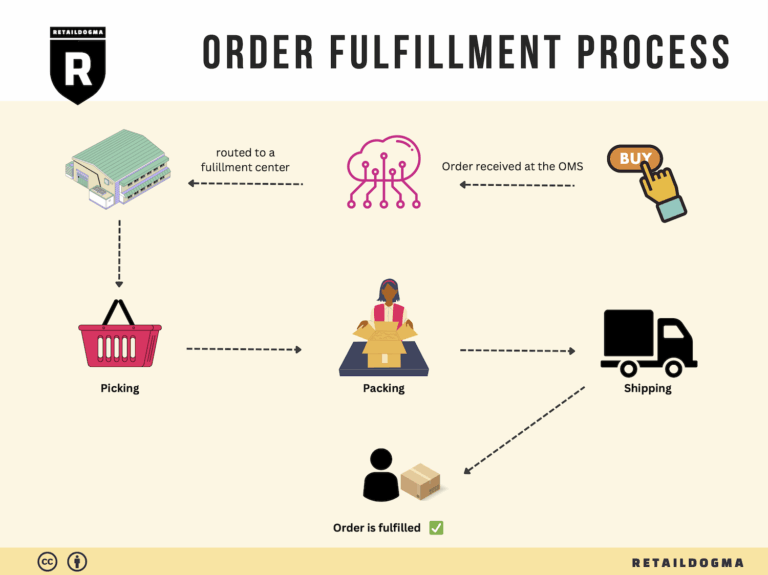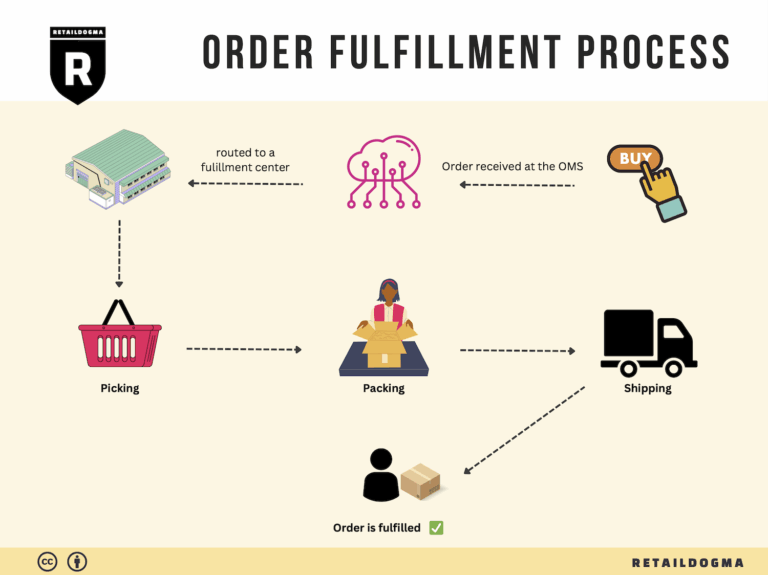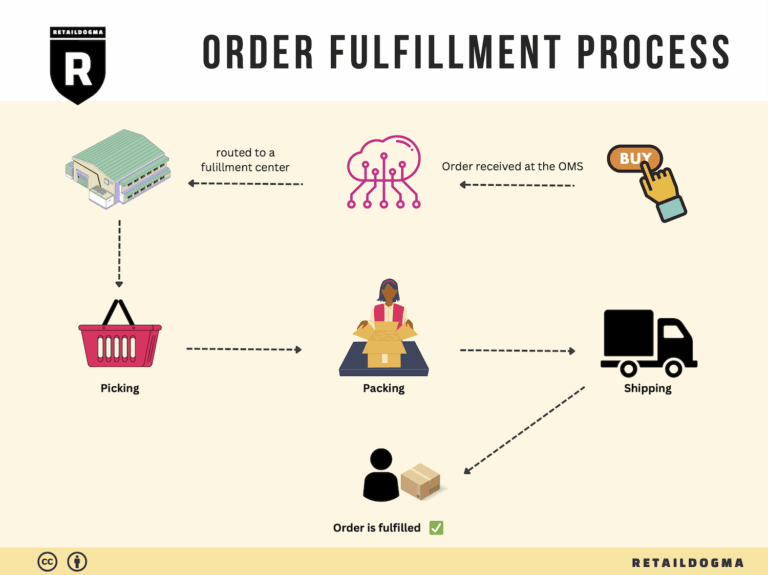What Is A Fulfillment Center? A Complete Guide (2025)
What is E-commerce Fulfillment? An Introduction for Growing Businesses
Understanding E-commerce Fulfillment for Growing Businesses
As an e-commerce business owner, you may find yourself grappling with the logistical challenges of packing and shipping orders. As your sales grow, the demands of fulfilling customer orders can quickly become overwhelming. The pressure to deliver products efficiently and accurately can strain your resources and distract you from focusing on strategic growth initiatives. This is where understanding e-commerce fulfillment becomes crucial.
At its core, e-commerce fulfillment is the comprehensive process of getting a product from your digital storefront into the hands of a satisfied customer. It encompasses a series of steps, including receiving and storing inventory, processing orders, picking and packing items, and ultimately shipping them out for delivery. Each of these stages plays a vital role in ensuring that your customers receive their orders on time and in good condition.
In this guide, we will explore the various fulfillment models available to growing businesses, such as third-party logistics (3PL) providers and Fulfillment by Amazon (FBA). We will delve into the core services involved in the fulfillment process, helping you understand what to expect from potential partners. Additionally, we will provide insights on how to choose the right fulfillment partner for your specific needs, taking into account factors like scalability, technology integration, and customer service.
Pricing is another critical aspect we will cover. Understanding the costs associated with different fulfillment models can help you make informed decisions that align with your budget and growth objectives. We’ll break down the various pricing structures and hidden costs to ensure you have a clear picture of what to expect.
Ultimately, this guide aims to empower you as a business owner to make smart decisions about your logistics operations. By optimizing your fulfillment strategy, you can enhance your customer experience, improve operational efficiency, and position your business for sustainable growth. Let’s navigate the complexities of e-commerce fulfillment together and set the stage for your success.
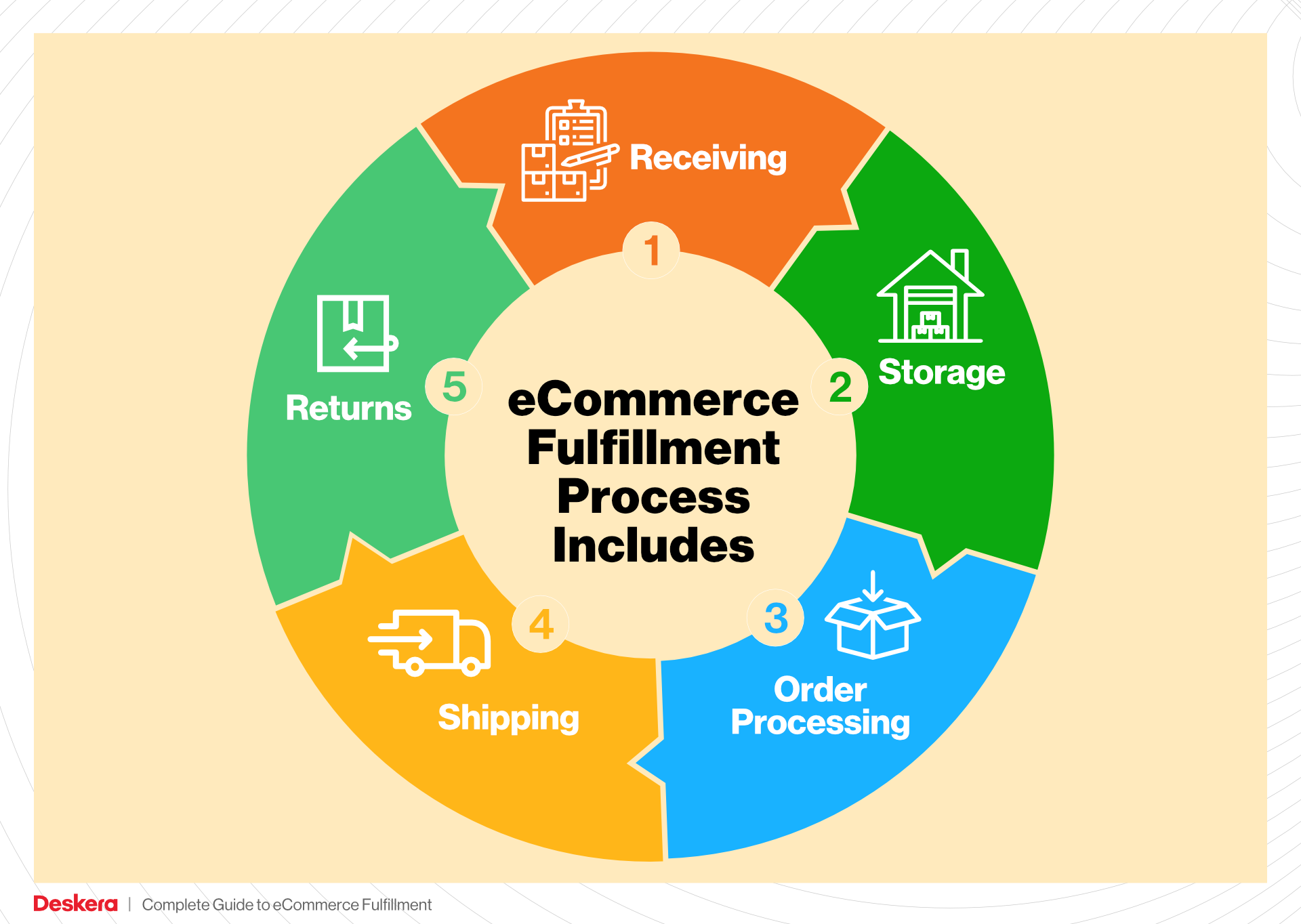
What You’ll Learn In This Guide
- What is E-commerce Fulfillment? An Introduction for Growing Businesses
- The Order Fulfillment Process: From ‘Buy’ Button to Customer’s Door
- Comparing Fulfillment Models: In-House vs. 3PL vs. Dropshipping
- A Deep Dive into Amazon FBA: Pros, Cons, and Who It’s For
- Core Services Offered by Fulfillment Centers
- How to Choose a Fulfillment Partner: A 6-Point Checklist
- Understanding Fulfillment Pricing: A Breakdown of Common Fees
- Frequently Asked Questions (FAQs) about Fulfillment
- Conclusion: Is Outsourcing Fulfillment the Right Move for Your Business?
- Important Disclaimer
The Order Fulfillment Process: From ‘Buy’ Button to Customer’s Door
1. Receiving Inventory
The order fulfillment process begins with the crucial step of receiving inventory. When products arrive at your fulfillment warehouse from suppliers or manufacturers, they must be unloaded, checked for accuracy, and recorded in your warehouse management system (WMS). This step is vital because it ensures that the correct quantities and SKUs (Stock Keeping Units) are accounted for, allowing you to maintain accurate inventory records.
During the receiving process, warehouse staff verify the shipment against the purchase order. Any discrepancies, such as damaged goods or incorrect quantities, must be documented and addressed immediately. Proper receiving practices help prevent stockouts and overselling, which can lead to lost sales and customer dissatisfaction. By establishing an efficient receiving protocol, businesses can streamline their operations and lay a solid foundation for the subsequent steps in the fulfillment process.
2. Warehouse Storage
Once the inventory is received and verified, the next step is warehouse storage. Items are systematically stored in designated locations within the warehouse to optimize accessibility and retrieval. Efficient storage strategies are essential for minimizing picking errors and reducing the time required to locate items.
Warehouses often employ various techniques for effective storage, such as slotting, where products are placed based on their turnover rate, or utilizing zone-based layouts that streamline the picking process. Maintaining accurate inventory data across all sales channels using an inventory management system (IMS) is critical at this stage. This ensures that stock levels are visible and up to date, helping to prevent issues like overselling or stockouts. An organized storage system not only enhances operational efficiency but also significantly improves customer satisfaction by ensuring faster order fulfillment.
3. Order Picking
Order picking is the stage where warehouse staff retrieve items from storage to fulfill customer orders. This step is critical as it directly impacts the speed and accuracy of the fulfillment process. When a customer places an order, the system generates a pick list, which outlines the SKUs and quantities needed for each order.
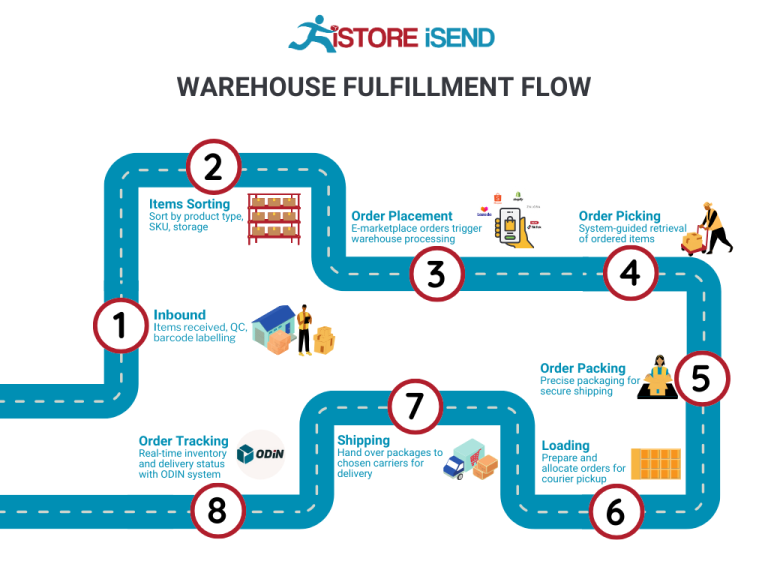
To maximize efficiency, fulfillment centers often use picking strategies such as batch picking, where similar orders are grouped together, or zone picking, where workers are assigned specific areas of the warehouse. Wave picking can also be utilized to synchronize picking with shipping schedules. The method chosen depends on factors like order volume and warehouse layout. Accurate picking is essential, as mistakes at this stage can lead to incorrect orders, resulting in customer dissatisfaction and increased return rates. Investing in technology, such as handheld scanners or mobile devices, can further enhance the picking process by ensuring real-time data accuracy and efficiency.
4. Order Packing
After items are picked, they move to the packing station, where they are prepared for shipment. Packing is not merely about placing items in boxes; it is a critical step that ensures products are protected during transit and presented well to the customer. Proper packing minimizes the risk of damage and reduces return rates, which can significantly impact profitability.
During this stage, items are scanned to confirm accuracy against the order before they are securely packed. Businesses can also enhance the customer experience by using branded packaging, eco-friendly materials, or including personalized inserts. This attention to detail can help build brand loyalty and create a positive unboxing experience. Effective packing methods can also optimize shipping costs by reducing dimensional weight and ensuring that packages are not oversized. A well-executed packing process is integral to maintaining high customer satisfaction levels and minimizing operational costs.
5. Shipping & Delivery
The final step in the order fulfillment process is shipping and delivery. Once the order is packed, it is handed over to a shipping carrier for final delivery to the customer. This stage is where fulfillment meets the customer, making it critical for managing expectations around speed and reliability.
Selecting the right carrier involves considering multiple factors, including delivery speed, cost, and destination. Many businesses leverage fulfillment platforms to automate carrier selection, ensuring the most cost-effective and SLA-compliant option is chosen. Accurate labeling and tracking information are generated at this stage, allowing customers to receive real-time updates about their orders. Proactive communication about shipping status can significantly enhance the customer experience and build trust in your brand. Strategic positioning of fulfillment centers can also optimize delivery times and costs, ensuring that customers receive their orders as quickly as possible. Ultimately, efficient shipping and delivery processes are essential for customer retention and brand reputation.

Comparing Fulfillment Models: In-House vs. 3PL vs. Dropshipping
Comparing Fulfillment Models
| Model | Who Handles Inventory | Best For (Business Stage) | Key Advantage | Key Disadvantage |
|---|---|---|---|---|
| In-House Fulfillment | The business itself | Startups and small businesses | Greater control over inventory and processes | Limited scalability and higher overheads |
| Third-Party Logistics (3PL) | Third-party logistics provider | Growing businesses and mid-sized brands | Access to expertise and infrastructure | Less control over inventory and fulfillment speed |
| Dropshipping | Supplier or manufacturer | New businesses and niche sellers | Low upfront investment and risk | Lower profit margins and less control over quality |
In-House Fulfillment
In-house fulfillment is the practice where businesses manage their entire order fulfillment process internally. This model is typically employed by startups and small businesses that have a manageable volume of orders. The key advantage of in-house fulfillment is the direct control it provides over inventory and fulfillment processes. Businesses can tailor their operations to fit specific needs, ensuring high-quality service that aligns with their brand image. However, this model also has significant drawbacks. As a business scales, managing increased order volumes can become cumbersome and costly, leading to challenges in efficiency and higher overhead expenses. Moreover, maintaining a warehouse, hiring staff, and investing in technology can stretch resources, making it difficult for small businesses to adapt quickly to market changes. This model is best suited for businesses that prioritize control and are prepared to invest in infrastructure and labor.
Third-Party Logistics (3PL)
Third-party logistics (3PL) involves outsourcing the logistics and fulfillment processes to specialized providers. This model is ideal for growing businesses and mid-sized brands that experience fluctuating order volumes and require flexibility. The primary advantage of 3PL is the access to professional logistics expertise and established infrastructure, which can significantly enhance efficiency and scalability. 3PL providers often have advanced technology and systems in place that streamline operations, from inventory management to shipping and returns. However, the trade-off is a reduction in control over inventory and fulfillment speed. Businesses must rely on their 3PL partner’s processes and capabilities, which can lead to challenges in maintaining brand consistency and customer satisfaction if the provider does not meet expectations. Therefore, selecting a reliable 3PL partner is critical, as it can directly influence the overall customer experience.
Dropshipping
Dropshipping is a fulfillment model where the retailer does not hold inventory but instead transfers customer orders directly to a supplier or manufacturer, who then ships the products on behalf of the retailer. This model is particularly attractive to new businesses and niche sellers due to its low upfront investment and minimal risk. With dropshipping, entrepreneurs can offer a wide range of products without the financial burden of purchasing and storing inventory. However, dropshipping comes with its own set of challenges. The most significant disadvantage is the typically lower profit margins, as retailers must pay the supplier’s price without having the ability to negotiate bulk rates. Additionally, quality control is a major concern; since retailers do not handle the products, they may face issues with product quality, shipping times, and customer service that can damage their brand reputation. For businesses that prioritize flexibility and low overhead costs, dropshipping can be an effective entry point into e-commerce, but they must be vigilant about supplier reliability and customer satisfaction.
In conclusion, choosing the right fulfillment model is a critical decision for e-commerce businesses as they scale. Each model—In-House Fulfillment, Third-Party Logistics, and Dropshipping—offers unique advantages and challenges. Businesses must carefully assess their current needs, growth potential, and resources to select the fulfillment strategy that aligns best with their operational goals and customer expectations.
A Deep Dive into Amazon FBA: Pros, Cons, and Who It’s For
Understanding Fulfillment by Amazon (FBA)
Fulfillment by Amazon (FBA) is a service offered by Amazon that allows e-commerce sellers to store their products in Amazon’s fulfillment centers. This service encompasses storage, packaging, shipping, and customer service, enabling sellers to leverage Amazon’s vast logistics network to fulfill orders. When a customer places an order for a product fulfilled by FBA, Amazon takes care of the entire fulfillment process, from picking the product off the shelf to shipping it directly to the customer’s doorstep.
How FBA Works
-
Product Listing: Sellers first create a product listing on Amazon. They can choose to enroll their products in the FBA program during this process.
-
Inventory Shipment: Sellers ship their products to Amazon’s fulfillment centers. Amazon provides guidelines on how to package and label products to ensure smooth processing upon arrival.
-
Storage: Once received, products are stored in Amazon’s warehouses. Inventory is organized and managed using Amazon’s sophisticated inventory management systems.
-
Order Fulfillment: When a customer orders a product, Amazon’s system automatically picks, packs, and ships the item. Customers benefit from Amazon’s fast shipping options, including same-day and two-day delivery through Amazon Prime.
-
Customer Service and Returns: Amazon also handles customer service inquiries and returns for FBA products, simplifying the post-purchase experience for sellers.
Pros of Using FBA
Prime Eligibility
One of the most significant advantages of FBA is that it grants products eligibility for Amazon Prime. This means that Prime members can receive products with expedited shipping options, which can significantly increase sales. The Prime badge enhances product visibility and can improve conversion rates, as many customers prefer to shop for Prime-eligible items.
Customer Trust
Amazon is a trusted brand with a robust customer service reputation. By using FBA, sellers can benefit from Amazon’s customer service and return policies. Customers often feel more secure purchasing from FBA sellers due to Amazon’s backing, which can lead to higher sales and fewer cart abandonments.
Multi-Channel Fulfillment
FBA is not limited to sales on Amazon’s platform. Sellers can use FBA to fulfill orders from other sales channels, such as their own websites or other online marketplaces. This flexibility allows businesses to centralize their inventory management and streamline order fulfillment across various platforms.
Cons of Using FBA
High Fees
While FBA can simplify logistics, it comes at a cost. Sellers are subject to various fees, including storage fees for inventory and fulfillment fees for each item sold. These costs can accumulate quickly, particularly for slow-moving products, which can erode profit margins if not managed carefully.
Strict Inventory Rules
Amazon imposes strict guidelines on inventory management. Sellers must adhere to regulations regarding packaging, labeling, and product quality. Non-compliance can lead to additional fees or even removal from the FBA program. Managing these rules can be cumbersome for sellers, particularly those new to the e-commerce landscape.
Commingling Risks
With FBA, sellers’ products are often commingled with those of other sellers. This means that when a customer orders a product, they may receive an item from a different seller’s inventory. This can lead to issues such as counterfeit concerns or poor-quality products being sent to customers, which can damage a seller’s reputation. Sellers may prefer to avoid this risk and choose to fulfill orders independently.
Who is FBA Best For?
Fulfillment by Amazon is particularly suited for sellers who are looking to scale their operations without investing heavily in logistics infrastructure. Here are specific scenarios where FBA can be especially beneficial:
-
Small to Medium-Sized Businesses: Companies that do not have the resources to manage their own warehousing and fulfillment can leverage FBA to access Amazon’s extensive logistics network.
-
High-Volume Sellers: Businesses that anticipate high sales volume can benefit from FBA’s speed and efficiency, particularly during peak shopping seasons.
-
Sellers of Consumer Goods: Products that are in demand and have a fast turnover rate are ideal for FBA, as it allows sellers to maximize the benefits of Prime eligibility.
-
Multi-Channel Retailers: For sellers who operate on multiple platforms, FBA’s multi-channel fulfillment option enables them to streamline their operations and maintain a single inventory.
-
New Sellers: Entrepreneurs just starting out in e-commerce can use FBA to focus on marketing and sales, while Amazon handles the complexities of fulfillment.
In summary, Fulfillment by Amazon can be a powerful tool for e-commerce businesses looking to simplify their logistics and enhance their reach. However, it is essential for sellers to carefully consider the associated costs and operational requirements to determine if FBA aligns with their business strategy.
Core Services Offered by Fulfillment Centers
Inventory Management & Warehousing
Inventory management and warehousing are foundational services provided by fulfillment centers, ensuring that e-commerce businesses can efficiently store and manage their products. This service begins with receiving inventory from suppliers, where items are checked for accuracy and condition before being stored in an organized manner within the warehouse.
Benefits:
1. Optimized Storage Solutions: Fulfillment centers employ strategic storage methods, such as slotting and zone-based layouts, to maximize space and minimize picking errors. By placing frequently ordered items closer to packing stations, they enhance operational efficiency.
-
Real-time Inventory Tracking: Advanced Warehouse Management Systems (WMS) allow for real-time inventory visibility across various sales channels. This capability helps businesses avoid overselling and stockouts, ensuring that customer demands are met promptly.
-
Scalability: As e-commerce businesses grow, their inventory needs can fluctuate significantly. Fulfillment centers offer scalable warehousing solutions, allowing businesses to adjust their storage space according to seasonal demands or sudden spikes in order volume without the overhead of maintaining their own warehouse.
Pick and Pack Services
The pick and pack process is a critical service where fulfillment centers streamline order fulfillment by efficiently selecting items from inventory and preparing them for shipping. Once an order is placed, the fulfillment center’s staff picks the necessary items based on detailed instructions and packs them securely for delivery.
Benefits:
1. Efficiency in Order Fulfillment: By employing methods such as batch picking, zone picking, or wave picking, fulfillment centers can significantly reduce the time it takes to gather products for shipment. This efficiency translates into faster delivery times, enhancing customer satisfaction.
-
Accurate Packing Practices: Fulfillment centers ensure that products are packed securely and correctly, minimizing the risk of damage during transit. They often use branded packaging, which not only protects items but also reinforces brand identity and improves the unboxing experience for customers.
-
Cost-Effectiveness: By outsourcing pick and pack services, e-commerce businesses can reduce labor costs and overhead associated with managing their own fulfillment operations. This allows businesses to focus on core activities such as marketing and customer engagement, while leaving logistics to experts.
Kitting and Assembly
Kitting and assembly services involve the grouping of individual items into ready-to-ship sets or kits. This service is particularly beneficial for businesses that offer bundled products or require assembly before shipment. Fulfillment centers can handle this intricate process efficiently, ensuring that all components of a kit are included and properly assembled.
Benefits:
1. Streamlined Operations: By outsourcing kitting and assembly, e-commerce businesses can simplify their operations. Fulfillment centers have the expertise and resources to assemble products quickly and accurately, reducing the burden on in-house teams.
-
Enhanced Product Offerings: Kitting allows businesses to create unique product offerings that can attract customers. For example, bundling complementary items can increase average order value and provide customers with a convenient shopping experience.
-
Improved Inventory Management: Fulfillment centers track components and kits in their inventory systems, providing accurate visibility into stock levels. This ensures that businesses can efficiently manage their inventory and avoid stockouts of popular kits.
Returns Management (Reverse Logistics)
Returns management, or reverse logistics, is an essential service provided by fulfillment centers to handle the return process efficiently. With e-commerce businesses facing higher return rates, especially in sectors like fashion and electronics, having a well-structured returns process can significantly impact customer satisfaction and loyalty.
Benefits:
1. Streamlined Returns Processing: Fulfillment centers facilitate a smooth returns process by providing clear instructions for customers, managing return shipping, and inspecting returned items. This efficiency helps in quickly restocking sellable items and reducing the time products are out of circulation.
-
Data-Driven Insights: By analyzing return patterns, fulfillment centers can provide valuable insights into product performance and customer preferences. Understanding why items are returned can help businesses make informed decisions regarding product quality, descriptions, and inventory management.
-
Customer Retention: A hassle-free return experience can enhance customer loyalty. Fulfillment centers often implement user-friendly return portals that simplify the process for customers, increasing the likelihood that they will make future purchases despite a return experience.
In summary, leveraging the core services offered by fulfillment centers—inventory management and warehousing, pick and pack services, kitting and assembly, and returns management—can significantly enhance the operational efficiency and customer satisfaction of e-commerce businesses. By outsourcing these essential functions, businesses can focus on growth and scaling while ensuring that their logistics operations run smoothly.
How to Choose a Fulfillment Partner: A 6-Point Checklist
Location & Warehouse Network
Importance:
The geographical location of your fulfillment partner’s warehouses significantly impacts shipping times, costs, and overall customer satisfaction. A partner with strategically located facilities can reduce transit times and shipping expenses, which is crucial for meeting customer expectations in today’s fast-paced e-commerce environment.
Questions to Ask:
– Where are your warehouses located, and how does this align with my target customer demographics?
– Do you have multiple fulfillment centers to cover regional demands effectively?
– How do you handle shipping logistics to ensure timely deliveries across various locations?
Technology & Integrations
Importance:
An effective fulfillment partner should utilize advanced technology to streamline operations, enhance accuracy, and provide real-time visibility into inventory and order status. Integration with your existing e-commerce platform is vital for seamless data flow, reducing the chances of errors and improving overall efficiency.
Questions to Ask:
– What order management systems (OMS) and warehouse management systems (WMS) do you use?
– How easily can your systems integrate with my e-commerce platform and other tools (e.g., inventory management, CRM)?
– Can you provide real-time tracking and reporting capabilities for my orders and inventory levels?
Specializations (e.g., Cold Storage, Oversized Items)
Importance:
Different products have varying storage and handling requirements. If your business involves specialized items—such as perishables that require cold storage, or oversized goods that need special handling—choosing a partner with the right capabilities is crucial to maintaining product integrity and customer satisfaction.
Questions to Ask:
– What types of products do you specialize in handling, and do you have the necessary facilities (like climate control) for sensitive items?
– Can you accommodate unique packaging or shipping requirements for my products?
– What experience do you have with handling returns for specialized items?
Scalability & Capacity
Importance:
As your business grows, your fulfillment needs will likely change. A suitable partner should not only support your current order volume but also have the capacity to scale operations quickly and efficiently as your business expands. This flexibility can prevent bottlenecks that could hinder growth.
Questions to Ask:
– What is your current capacity for order fulfillment, and how do you manage peak seasons or unexpected spikes in demand?
– Can you handle seasonal fluctuations in my order volume without compromising service quality?
– What systems do you have in place to ensure that you can scale operations in line with my business growth?
Pricing and Contracts
Importance:
Understanding the pricing structure and contract terms of your fulfillment partner is critical to ensuring that your operations remain profitable. Clarity on costs—including storage fees, pick-and-pack fees, shipping rates, and any hidden charges—will help you avoid unexpected expenses that could erode your margins.
Questions to Ask:
– Can you provide a detailed breakdown of your pricing structure, including any additional fees?
– What is the length of your contracts, and what options do I have for termination or renegotiation?
– Are there volume discounts or incentives for long-term partnerships?
Customer Support & Reviews
Importance:
Effective customer support is essential for addressing issues that may arise during the fulfillment process. A responsive partner can help resolve problems quickly, minimizing disruptions to your operations. Additionally, examining customer reviews and testimonials can provide insight into the partner’s reliability and service quality.
Questions to Ask:
– What customer support options do you offer (e.g., phone, email, live chat), and what are your response times?
– Can you provide references or case studies from other clients in my industry?
– How do you handle disputes or issues that may arise during the fulfillment process?
By utilizing this checklist, e-commerce business owners, operations managers, and entrepreneurs can make informed decisions when selecting a fulfillment partner. Each point emphasizes critical factors that will not only support current operational needs but also facilitate sustainable growth and enhance customer satisfaction.
Understanding Fulfillment Pricing: A Breakdown of Common Fees
Initial Setup Fees
When partnering with a fulfillment provider, initial setup fees are often the first costs you encounter. These fees cover the onboarding process, which includes integrating your e-commerce platform with the fulfillment provider’s systems, setting up inventory management, and establishing operational workflows.
Typically, initial setup fees can range from a few hundred to several thousand dollars, depending on the complexity of your business and the services offered by the provider. Factors affecting the cost include the number of SKUs, the level of customization needed, and whether you require additional services like branded packaging or specific reporting tools.
Receiving Fees
Receiving fees are charged when your inventory arrives at the fulfillment center. This fee covers the labor and resources required to unload, inspect, and store your products.
These fees are usually calculated based on the volume of goods being received, often measured in pallets or individual units. For example, you might see a charge of $25 to $100 per pallet, or a per-unit cost ranging from $0.10 to $0.50, depending on the fulfillment center’s pricing structure.
Keep in mind that if your inventory arrives in bulk, additional charges may apply for any special handling required, such as sorting or repackaging.
Storage Fees (per pallet/bin)
Storage fees are incurred for the space your inventory occupies in the fulfillment center. This fee is generally calculated on a monthly basis and can vary significantly based on location, demand, and the type of inventory being stored.
Most fulfillment centers charge a fee per pallet or bin. For instance, storage fees might range from $10 to $40 per pallet per month. Smaller items may be charged by bin space, with costs typically between $2 and $10 per bin monthly.
It’s important to monitor your inventory levels, as overstocking can lead to higher storage costs, impacting your overall profitability. Some providers may offer tiered pricing, where costs decrease as your volume increases, so be sure to inquire about this option.
Pick & Pack Fees (per item/order)
Pick and pack fees are charged for the labor involved in selecting items from storage and preparing them for shipment. This fee can be structured in various ways—per item, per order, or as a combination of both.
Commonly, you might encounter a pick fee of $1 to $3 per item and a pack fee of $0.50 to $2 per order. Some fulfillment providers offer flat-rate pricing for bulk orders, which can help you manage costs if you frequently ship high volumes.
Understanding how these fees are calculated can help you optimize your order sizes and frequency to minimize costs. For example, consolidating multiple items into a single order can reduce the overall pick and pack fees.
Shipping Fees
Shipping fees are perhaps the most variable costs associated with fulfillment and can significantly impact your bottom line. These fees cover the costs associated with transporting your products from the fulfillment center to your customers.
Shipping fees are typically calculated based on several factors, including the weight and dimensions of the package, the shipping destination, and the selected shipping method (standard, expedited, etc.). Most fulfillment centers will have partnerships with various carriers and may offer discounted rates based on your shipping volume.
To accurately estimate shipping fees, it’s advisable to conduct a shipping audit with your fulfillment provider. This audit can help you understand your shipping patterns, identify the most cost-effective carriers, and optimize your shipping strategy based on current rates and delivery times.
Tips for Getting an Accurate Quote
-
Be Transparent About Your Needs: When seeking quotes from fulfillment providers, provide as much detail as possible about your order volume, product types, and specific requirements. This will help them give you a tailored estimate.
-
Consider Hidden Fees: Always ask about any additional charges that may not be immediately apparent, such as surcharges for special handling, returns processing, or inventory audits.
-
Request a Breakdown of Costs: A detailed breakdown of each fee type will help you understand where your money is going and allow you to compare providers effectively.
-
Negotiate Rates: Depending on your order volume and long-term potential, don’t hesitate to negotiate fees. Many fulfillment centers are willing to offer discounts for higher volumes or long-term contracts.
-
Evaluate the Total Cost of Ownership: Instead of focusing solely on individual fees, consider the total cost of ownership, which includes all associated costs of fulfillment. This will give you a clearer picture of how each provider fits into your overall budget and profitability goals.
By understanding these common fulfillment fees and their calculations, you can make informed decisions that align with your e-commerce growth objectives while keeping costs under control.
Frequently Asked Questions (FAQs) about Fulfillment
1. What is an order fulfillment system?
An order fulfillment system is a coordinated process that manages the end-to-end logistics of getting products from your digital storefront to customers. It involves inventory management, order processing, picking, packing, shipping, and handling returns. A robust fulfillment system ensures that orders are processed efficiently, accurately, and in a timely manner, ultimately enhancing customer satisfaction.
2. What’s the difference between a warehouse and a fulfillment center?
A warehouse is primarily a storage facility where goods are kept until needed, while a fulfillment center is specialized for order processing and logistics. Fulfillment centers are equipped to handle various aspects of order fulfillment, including inventory management, picking and packing, shipping, and returns processing, with a focus on speed and efficiency to meet customer expectations.
3. What is a 3PL (Third-Party Logistics)?
A 3PL, or Third-Party Logistics provider, is an external company that manages a business’s logistics operations, including warehousing, inventory management, order fulfillment, and shipping. Partnering with a 3PL allows businesses to scale their operations without the need for significant infrastructure investment, leveraging the 3PL’s expertise and resources to improve efficiency and reduce costs.
4. How much do fulfillment services cost?
Fulfillment service costs vary widely based on factors such as order volume, product type, service levels, and geographic location. Typically, costs may include storage fees, picking and packing fees, shipping charges, and additional service fees for returns or special handling. It’s essential to request quotes from multiple providers and understand their pricing structures to find the best fit for your business.
5. How can I improve my order fulfillment process?
To enhance your order fulfillment process, consider the following strategies:
– Invest in technology, like a Warehouse Management System (WMS) or Order Management System (OMS), to automate and streamline operations.
– Optimize your warehouse layout for efficient picking and packing.
– Implement inventory management best practices to maintain accurate stock levels.
– Develop clear communication channels for customer updates regarding order status and shipping.
– Analyze fulfillment metrics to identify areas for improvement.
6. What are the benefits of outsourcing fulfillment?
Outsourcing fulfillment offers several benefits, including:
– Cost savings on labor, storage, and shipping as providers can often negotiate better rates.
– Access to advanced technology and logistics expertise without the need for significant investment.
– Scalability, allowing businesses to easily adjust to changing order volumes.
– Improved focus on core business activities, such as marketing and product development, while leaving logistics to experts.
7. What should I look for in a fulfillment partner?
When selecting a fulfillment partner, consider the following criteria:
– Experience and expertise in your industry.
– Technology integration capabilities with your existing systems.
– Flexibility to accommodate your business growth and changing needs.
– Quality of customer service and communication.
– Performance metrics and reporting capabilities to track efficiency and accuracy.
8. How do I handle returns in my fulfillment process?
Handling returns effectively involves creating a streamlined reverse logistics process. This includes:
– Providing clear return instructions for customers.
– Implementing a return authorization system to manage returns efficiently.
– Inspecting returned items promptly and processing refunds or exchanges quickly.
– Analyzing return data to identify patterns and improve product offerings or fulfillment processes.
9. Can I manage order fulfillment in-house?
Yes, businesses can manage order fulfillment in-house, especially if they have a manageable volume of orders. This approach allows for greater control over the fulfillment process and can reduce costs. However, as order volumes grow, businesses may face challenges in scaling operations, which can lead to inefficiencies and increased overhead.
10. How does shipping impact customer satisfaction?
Shipping is a critical component of customer satisfaction, as it directly affects order delivery times and reliability. Customers expect timely and accurate deliveries, and poor shipping experiences can lead to negative reviews and lost business. To enhance shipping satisfaction, provide clear tracking information, set realistic delivery expectations, and proactively communicate any delays.
Conclusion: Is Outsourcing Fulfillment the Right Move for Your Business?
Evaluating the Benefits of Outsourcing Fulfillment
Outsourcing your fulfillment process can be a game-changer for your e-commerce business, particularly as you scale. By partnering with a reliable fulfillment service, you can save significant time and resources, allowing you to focus on core business activities such as marketing and customer engagement. This time savings can translate into improved operational efficiency, enabling you to respond more swiftly to market demands and customer needs.
Scalability is another compelling reason to consider outsourcing. As your sales volume grows, managing fulfillment in-house can become increasingly complex and resource-intensive. A third-party logistics provider (3PL) offers the infrastructure and flexibility needed to scale your operations seamlessly, handling everything from inventory management to shipping logistics. This means you can grow your business without the burden of expanding your facilities or workforce.
Moreover, leveraging the expertise of a fulfillment partner can enhance your overall customer experience. These providers often come equipped with advanced technology, industry knowledge, and best practices that can optimize your supply chain and reduce operational costs. This expertise is crucial in meeting customer expectations for timely deliveries and hassle-free returns, ultimately fostering brand loyalty.
However, the success of outsourcing hinges on selecting the right partner. A thorough vetting process is essential to ensure that the provider aligns with your business goals and can deliver the service quality your customers expect.
Next Steps
Take a moment to audit your current shipping and fulfillment processes. Assess whether your existing approach meets your growth ambitions or if the time has come to explore fulfillment partnerships. By strategically evaluating your options, you can position your business for sustainable growth while enhancing customer satisfaction.
Important Disclaimer
⚠️ Important Disclaimer
The information in this guide is for educational purposes. Fulfillment services, pricing, and platform features change frequently. Always conduct your own due diligence and consult with providers directly before making business decisions.
